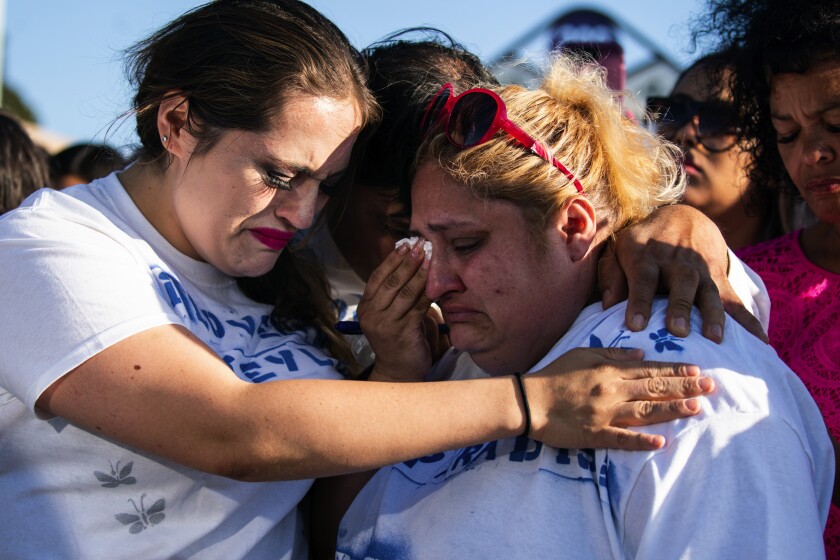
By JILLIAN PETERSON AND JAMES DENSLEYAUG
In the last week, more than 30 people have died in three separate mass shootings in Gilroy, El Paso and Dayton, Ohio. We believe that analyzing and understanding data about who commits such massacres can help prevent more lives being lost.
For two years, we’ve been studying the life histories of mass shooters in the United States for a project funded by the National Institute of Justice, the research arm of the U.S. Department of Justice. We’ve built a database dating back to 1966 of every #massshooter who shot and killed four or more people in a public place, and every shooting incident at schools, workplaces, and places of worship since 1999. We’ve interviewed incarcerated perpetrators and their families, shooting survivors and first responders. We’ve read media and #socialmedia, manifestos, #suicide notes, trial transcripts and medical records.
Our goal has been to find new, data-driven pathways for preventing such shootings. Although we haven’t found that #massshooters are all alike, our data do reveal four commonalities among the perpetrators of nearly all the #massshootings we studied.
JamesDonaldson notes:
Welcome to the “next chapter” of my life… being a voice and an advocate for #mentalhealthawarenessandsuicideprevention, especially pertaining to our younger generation of students and student-athletes.
Getting men to speak up and reach out for help and assistance is one of my passions. Us men need to not suffer in silence or drown our sorrows in alcohol, hang out at bars and strip joints, or get involved with drug use.
Having gone through a recent bout of #depression and #suicidalthoughts myself, I realize now, that I can make a huge difference in the lives of so many by sharing my story, and by sharing various resources I come across as I work in this space. #http://bit.ly/JamesMentalHealthArticle
First, the vast majority of mass shooters in our study experienced early childhood trauma and exposure to violence at a young age. The nature of their exposure included parental #suicide, physical or sexual abuse, neglect, domestic violence, and/or severe bullying. The trauma was often a precursor to #mentalhealth concerns, including #depression, #anxiety, thought disorders or #suicidality.
Second, practically every #massshooter we studied had reached an identifiable crisis point in the weeks or months leading up to the shooting. They often had become angry and despondent because of a specific grievance. For workplace shooters, a change in job status was frequently the trigger. For shooters in other contexts, relationship rejection or loss often played a role. Such crises were, in many cases, communicated to others through a marked change in behavior, an expression of #suicidal thoughts or plans, or specific threats of violence.
Third, most of the shooters had studied the actions of other shooters and sought validation for their motives. People in crisis have always existed. But in the age of 24-hour rolling news and #socialmedia, there are scripts to follow that promise notoriety in death. Societal fear and fascination with #massshootings partly drives the motivation to commit them. Hence, as we have seen in the last week, #massshootings tend to come in clusters. They are socially contagious. Perpetrators study other perpetrators and model their acts after previous shootings. Many are radicalized online in their search for validation from others that their will to murder is justified.
Fourth, the shooters all had the means to carry out their plans. Once someone decides life is no longer worth living and that murdering others would be a proper revenge, only means and opportunity stand in the way of another mass shooting. Is an appropriate shooting site accessible? Can the would-be shooter obtain firearms? In 80% of school shootings, perpetrators got their weapons from family members, according to our data. Workplace shooters tended to use handguns they legally owned. Other public shooters were more likely to acquire them illegally.
So what do these commonalities tell us about how to prevent future shootings?
One step needs to be depriving potential shooters of the means to carry out their plans. Potential shooting sites can be made less accessible with visible security measures such as metal detectors and police officers. And weapons need to be better controlled, through age restrictions, permit-to-purchase licensing, universal background checks, safe storage campaigns and red-flag laws — measures that help control firearm access for vulnerable individuals or people in crisis.
Another step is to try to make it more difficult for potential perpetrators to find validation for their planned actions. Media campaigns like #nonotoriety are helping starve perpetrators of the oxygen of publicity, and technology companies are increasingly being held accountable for facilitating mass violence. But we all can slow the spread of #massshootings by changing how we consume, produce, and distribute violent content on media and #socialmedia. Don’t like or share violent content. Don’t read or share killers’ manifestos and other hate screeds posted on the internet. We also need to study our current approaches. For example, do lockdown and active shooter drills help children prepare for the worst or hand potential shooters the script for mass violence by normalizing or rehearsing it?
We also need to, as a society, be more proactive. Most mass public shooters are #suicidal, and their crises are often well known to others before the shooting occurs. The vast majority of #massshooters leak their plans ahead of time. People who see or sense something is wrong, however, may not always say something to someone owing to the absence of clear reporting protocols or fear of overreaction and unduly labeling a person as a potential threat. Proactive violence prevention starts with schools, colleges, churches and employers initiating conversations about #mentalhealth and establishing systems for identifying individuals in crisis, reporting concerns and reaching out — not with punitive measures but with resources and long-term intervention. Everyone should be trained to recognize the signs of a crisis.
Proactivity needs to extend also to the traumas in early life that are common to so many #massshooters. Those early exposures to violence need addressing when they happen with ready access to social services and high-quality, affordable #mentalhealthtreatment in the community. School counselors and social workers, employee wellness programs, projects that teach resilience and social emotional learning, and policies and practices that decrease the #stigma around #mentalillness will not just help prevent mass shootings, but will also help promote the social and emotional success of all Americans.
Our data show that #massshooters have much in common. Instead of simply rehearsing for the inevitable, we need to use that data to drive effective prevention strategies.
Jillian Peterson is a psychologist and professor of criminology and criminal justice at Hamline University. James Densley is a sociologist and professor of criminal justice at Metropolitan State University. Together, they run the Violence Project.




